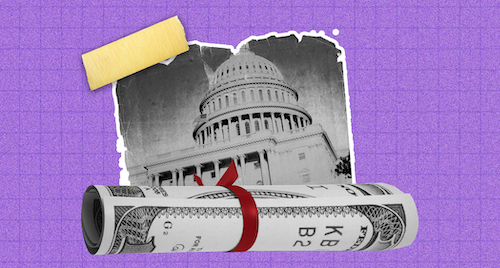Economics Professor Patricia Smith has researched wealth gaps and poverty for decades. Access to education plays a role in this — but she says broad-based programs may not be the best method to close the income gap. Drawing from economics research, Smith adds to the national conversation about debt relief, education access and why a more targeted approach may be more beneficial for the country’s most vulnerable populations.
Question: How is student loan forgiveness beneficial to our economy?
Patricia Smith: Economists at Harvard studied a ‘natural experiment’ in which a student loan lender had to cancel all its loans. They found that individuals who had loans forgiven in this situation were more likely to switch to a higher paying job. Since employers often review job applicants’ credit records and favor those with good credit, student loan forgiveness helps those in default on their student loans by erasing that blemish from their credit record, improving their employment prospects. These researchers also found that those whose student debts were forgiven tended to pay down their other debts and spent more money.
Q: In the American Rescue Plan (ARP), it says that student loan forgiveness is non-taxable through 2025. What does this mean — and how does this help students now?
PS: The IRS generally treats loan forgiveness as income, thus subject to taxation. For example, if the federal government forgives your $10,000 student loan debt and you’re in the 30% income tax bracket, then you would owe $3,000 in income taxes. The ARP provision takes that $3,000 tax bill away.
While President Biden has stated his support for student loan forgiveness of up to $10,000, this has not yet been enacted. The ARP provision will impact those who secured a student loan in an Income-Driven Payment program and reach the end of their loan period — 20 to 25 years depending on the particular program — between now and 2025. At the end of the loan period in these programs all remaining student debt is forgiven and thus would benefit from the new tax-exempt status. A 2017 tax law eliminated tax liability on student loan forgiveness in the case of death or disability of the debtor and it expires at the end of 2025 — perhaps the ARP deadline was set to match that program.
Q: This was part of an economic stimulus package, how does this fit?
PS: Making student loan debt forgiveness tax exempt would get some money out into the economy and boost economic activity. However, the tax-free status by itself would be a relatively small boost. To get a bigger boost from policy related to student loans, significant broad-based debt forgiveness would be necessary.
Q: So there are economic benefits to forgiveness, but not enough. Policy wise, is there an economic reason to combine debt relief with universal free college?
PS: Student debt forgiveness only helps those who have already attended college and took out a federal loan to do so. This doesn’t help new students or students who paid their way without a federal loan.
States have generally reduced funding for higher education and that has pushed tuition up. However, we want people to have access because post high school education, either college or some other type of skills training, is vital for both individuals and for the economy as a whole because economic well-being depends on the productivity of labor. We’ve seen bursts of economic growth following significant public investment in education, for example the universal high school movement in the early 1900s and the G.I. Bill in the mid-1940s.
Student loan debt forgiveness and free- or reduced-tuition programs have two different policy results. The former would provide relief to student debt holders and spur consumer purchases; the latter would encourage people to go to college or trade school and develop the skills needed in our labor force.
Q: As a country, is student loan forgiveness a smart investment?
PS: It only makes economic sense to undertake a particular action, such as student debt forgiveness, if the benefits exceed the costs. Forgiving all student debt would cost about $1.6 trillion. That’s more than we spend on safety net programs such as Unemployment Insurance, Medicaid, food stamps and the Earned Income Tax Credit — combined.
The Brookings Institution reports that the average food stamp participant earns $19,000 and 50% are poor. In contrast, the average student loan holder earns $76,400 on average and only 7% are poor. Economists at Wharton and the University of Chicago estimate that universal student loan forgiveness or forgiveness of up to $50,000 of student debt would benefit higher-income adults more than lower-income adults. For example, the top 30% of earners would get 50% of the dollars forgiven in the case of universal student loan forgiveness. Greater benefits to higher earners would contribute to economic inequality. If reducing income gaps is the goal, broad-based student loan forgiveness likely is not the best strategy.
Q: What’s a better solution?
PS: If our goal is to reduce income inequality through student loan forgiveness, researchers recommend making Income-Driven Payment programs — having payments adjusted to your income and family size — more generous and targeting middle- and low-income earners.
Q: So it won’t do much for income gaps among adult learners. What about lessening racial disparities?
PS: When it comes to how it will help among racial disparities, a team of researchers at the Roosevelt Institute estimate that white student loan holders would benefit more in terms of the absolute number of dollars forgiven, but that Black student debt holders would secure larger relative benefits — benefits compared to household net worth. The Federal Reserve reports that in 2019 median household net worth was $188,200 for Whites, $24,100 for Blacks and $36,100 for Hispanics.
The Wharton-University of Chicago team estimates that universal student debt forgiveness would benefit Blacks and white students about the same, while Hispanics and other groups would benefit less. Student debt forgiveness probably won’t reduce racial wealth gaps by much.
Q: Would free education beyond high school reduce income gaps?
PS: The Brookings Institution estimates that students in the top half of the income distribution would receive 24% more benefits (measured in dollars) from universal free college than those in the bottom half of the distribution. Expanding Pell Grants would be a more effective way to increase college attendance among lower-income students.
We also need to remember that while tuition is a major cost of college, it isn’t the only cost. Housing, food, transportation, books and computers also pose barriers for low-income students. The opportunity cost of attending college is also significant — the more time you spend on school, the less time you have to work and earn money. This impacts low-income students more than higher-income students.
Q: Finally, if free post-secondary education for all isn’t the best solution for reducing income inequality, what is?
PS: Success in college depends on many factors that shape the individual long before they reach college age. While lowering tuition would enable more low-income students to enter college, that doesn’t mean they’ll be able to complete a degree.
Children who grow up in chronic poverty are more likely to experience unstable housing, exposure to environmental hazards and other stressors that can affect development. K-12 schools in low-income areas are frequently under-resourced, so their graduates often lack critical skills and foundational knowledge needed to complete a college program. Colleges and other post-high school training need to expand financial aid based on need and support services to compensate for the inequalities children experience before they get to college.
Reducing income inequality through education requires reducing childhood poverty and improving our educational system starting with early childhood education. In short, education needs to be a higher priority for all levels of government.
Interview by Sarah Tuxbury. If you’re a member of the media and would like to speak with Professor Patricia Smith about this topic, please drop us a line at UMDearborn-News@umich.edu.





